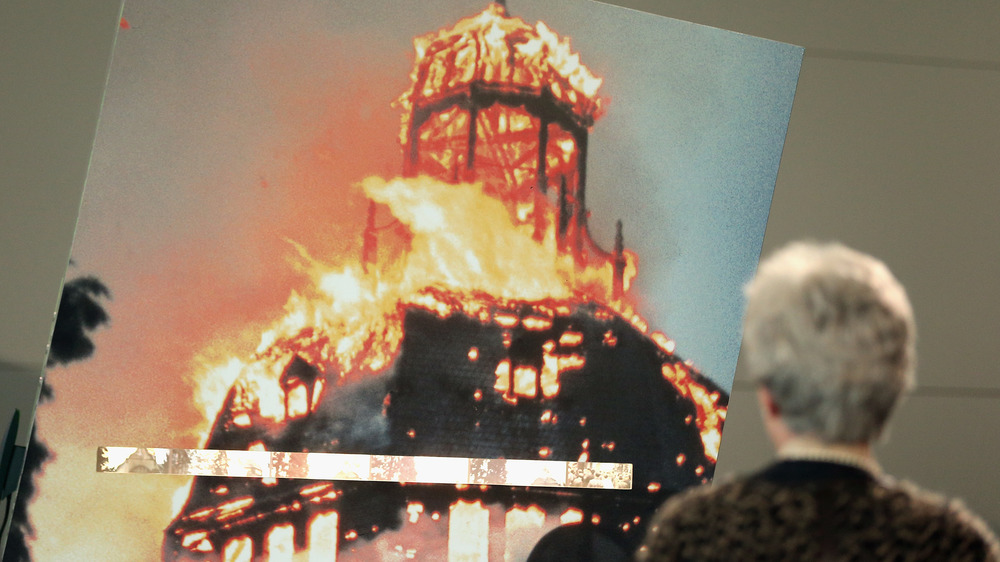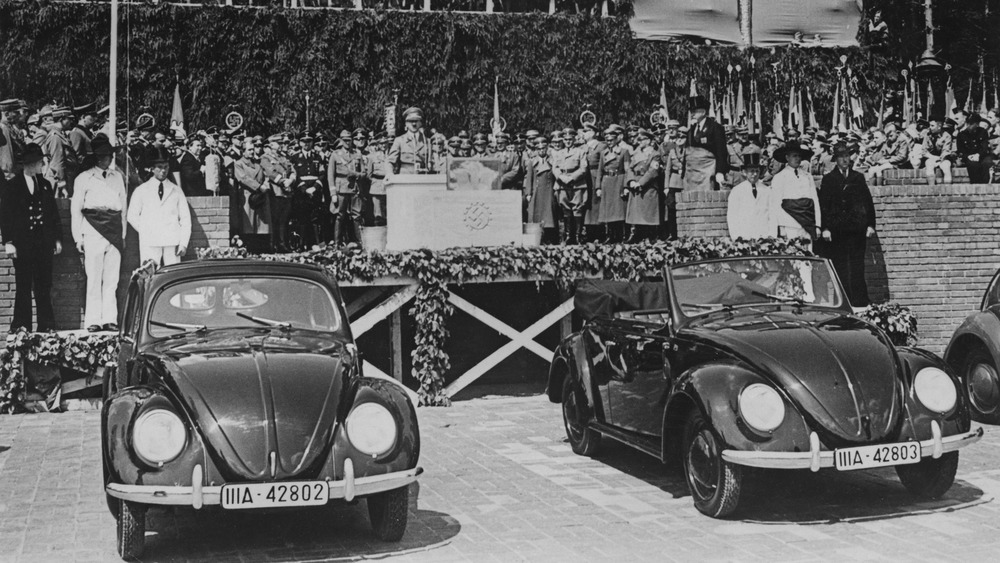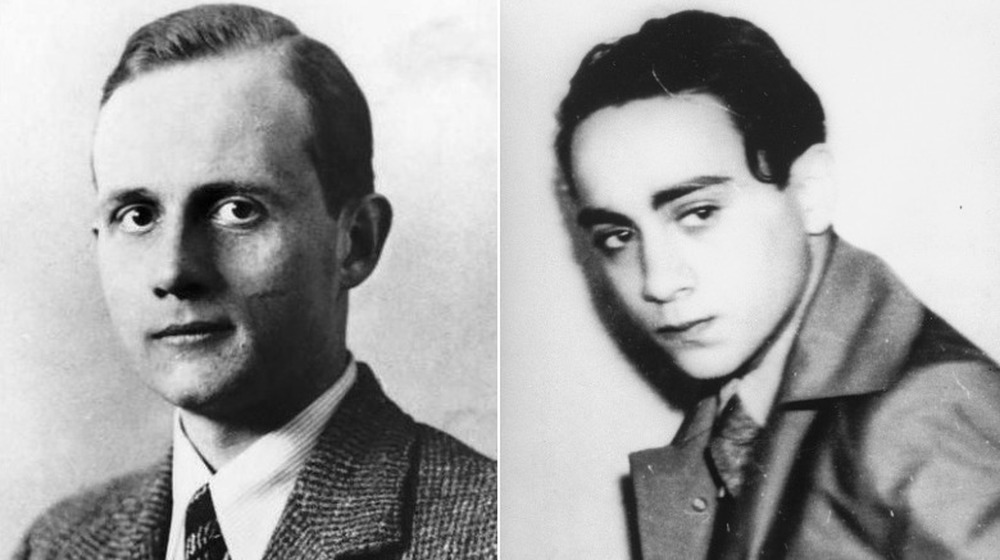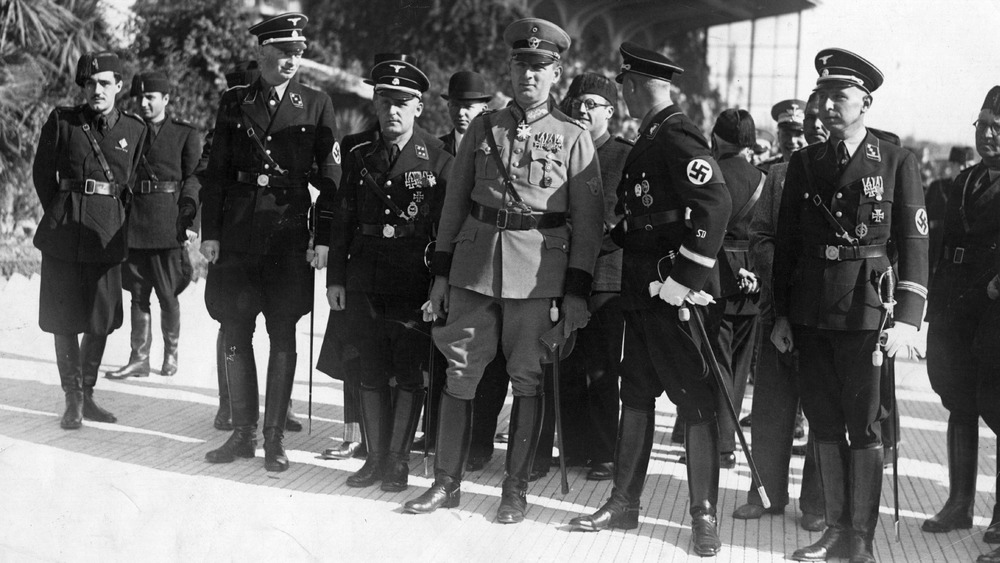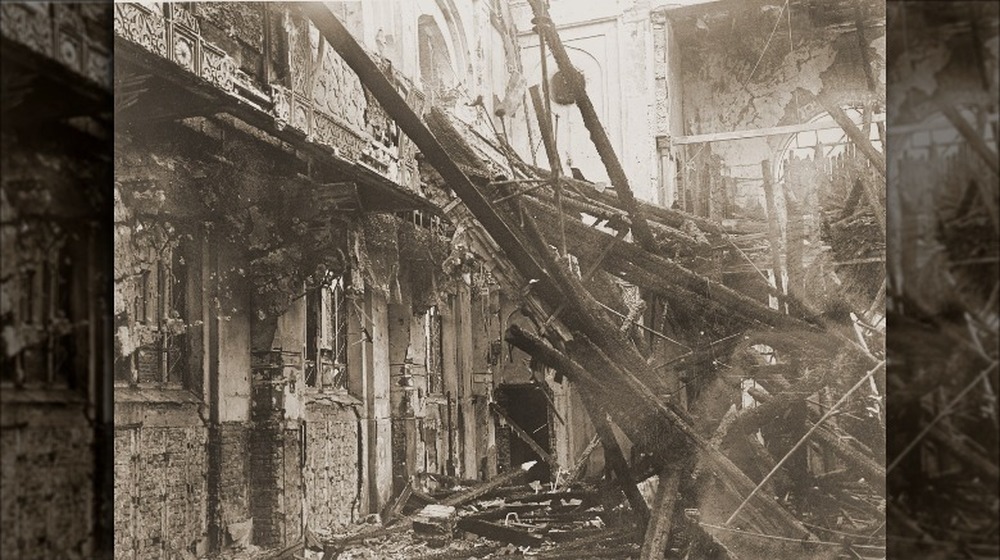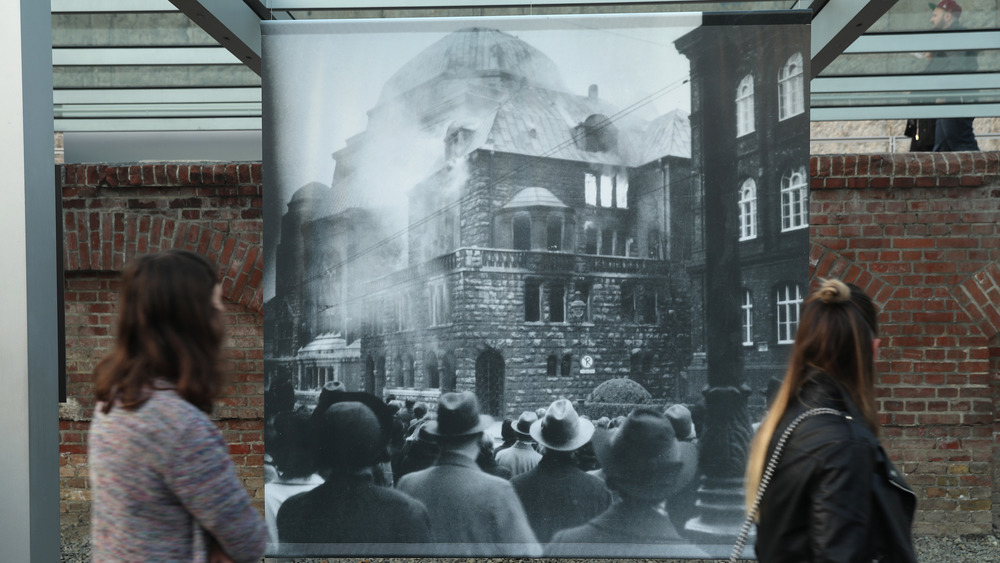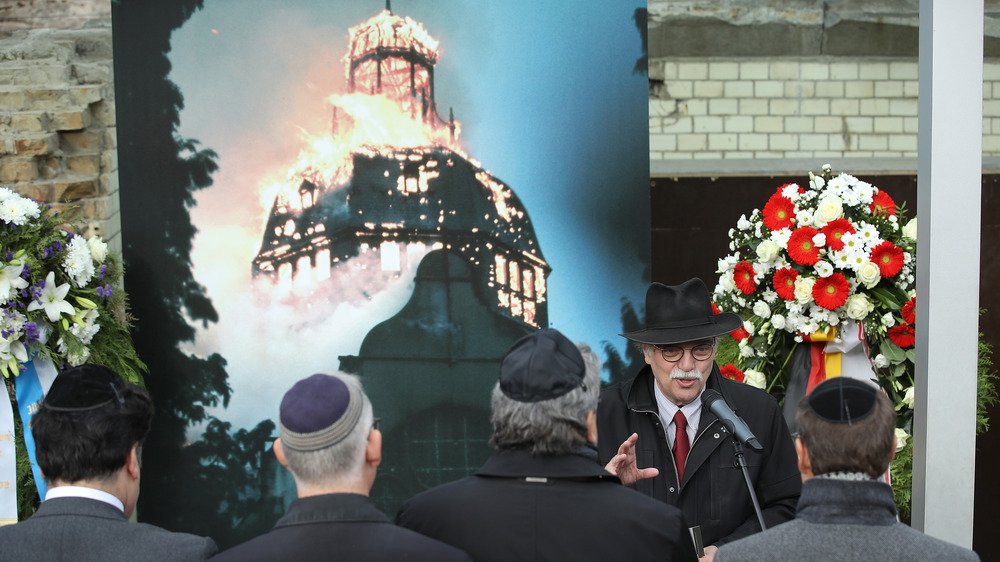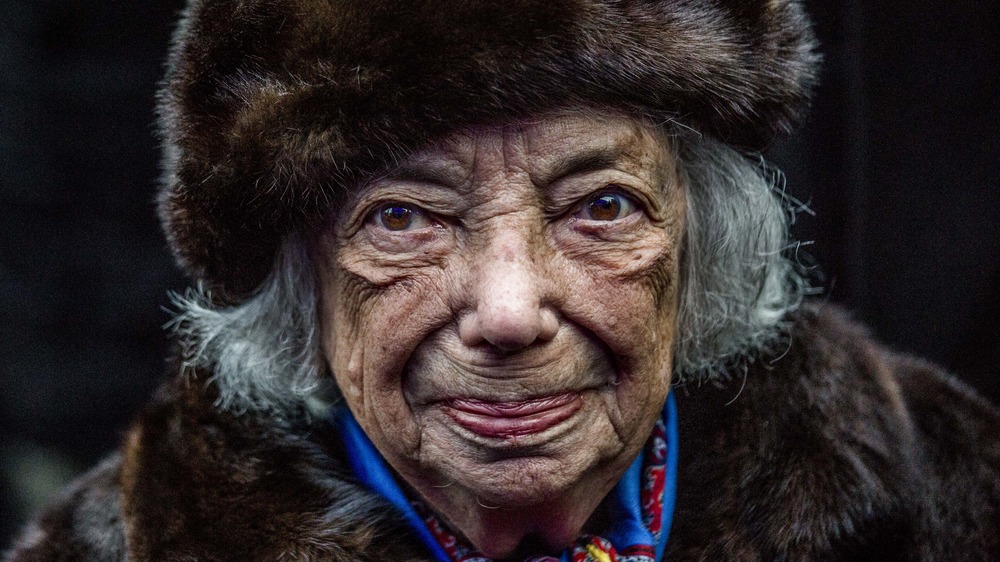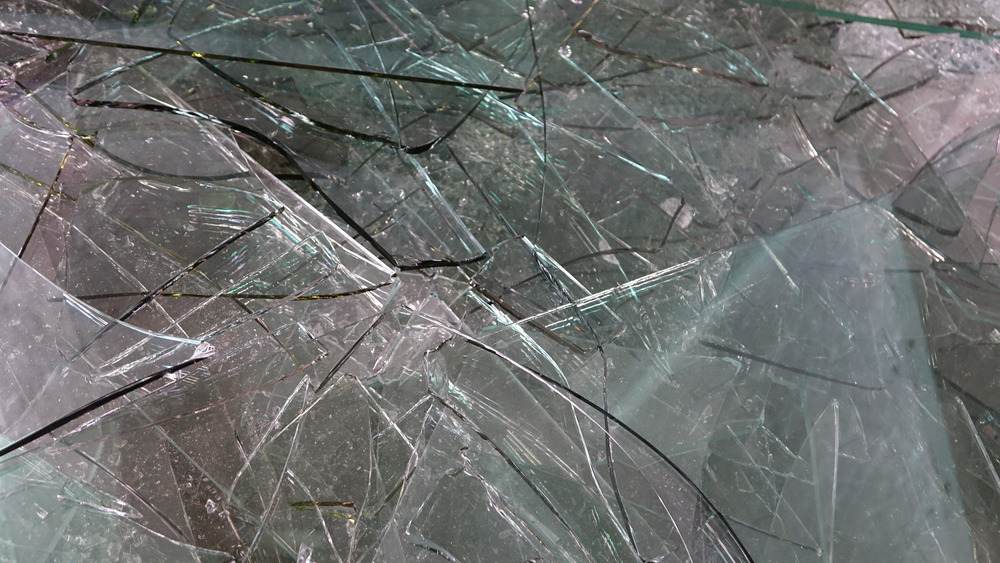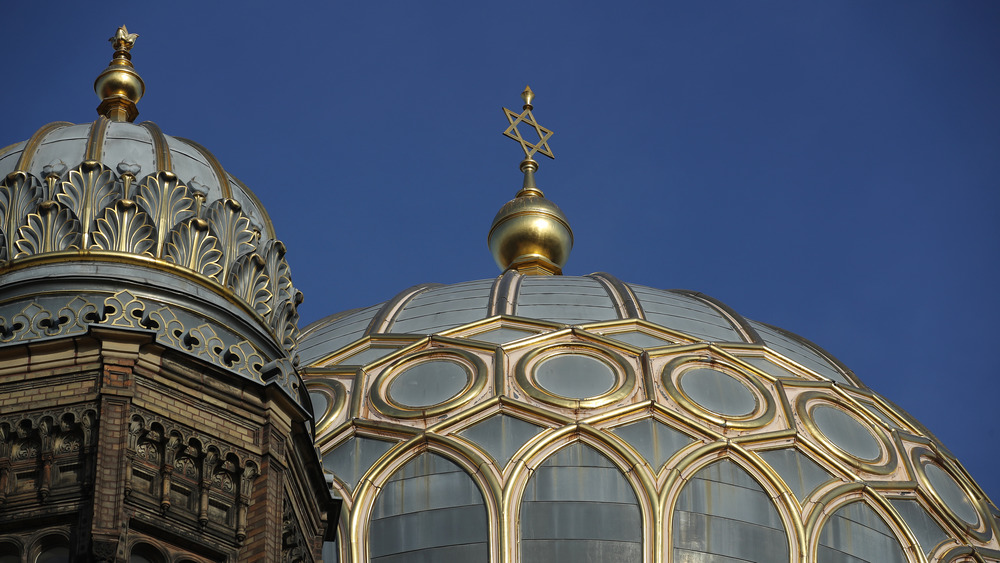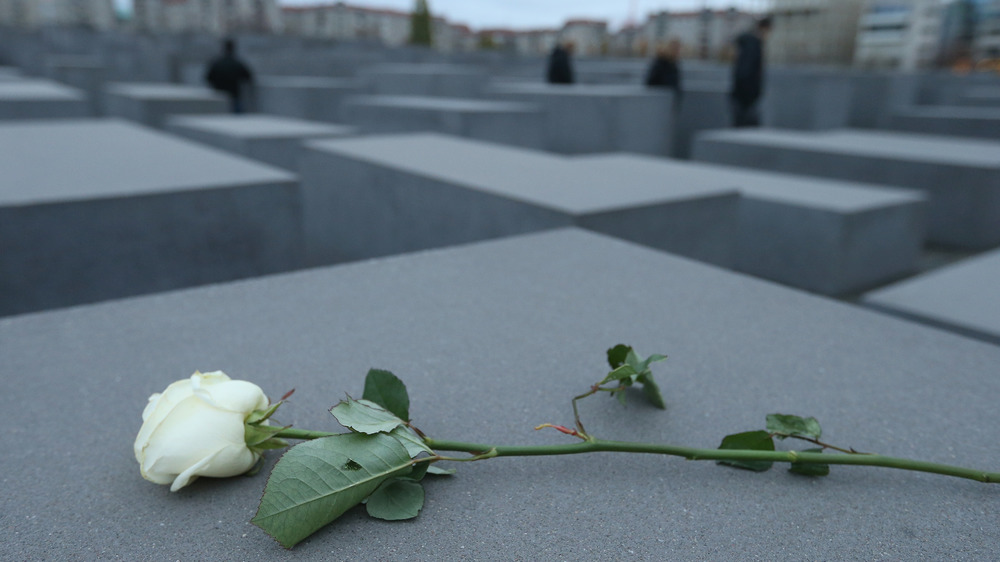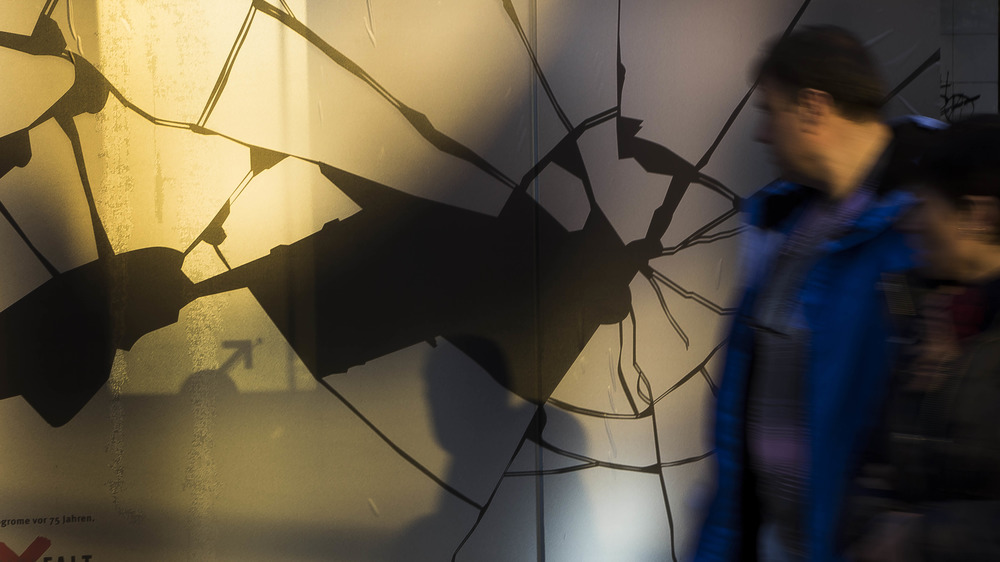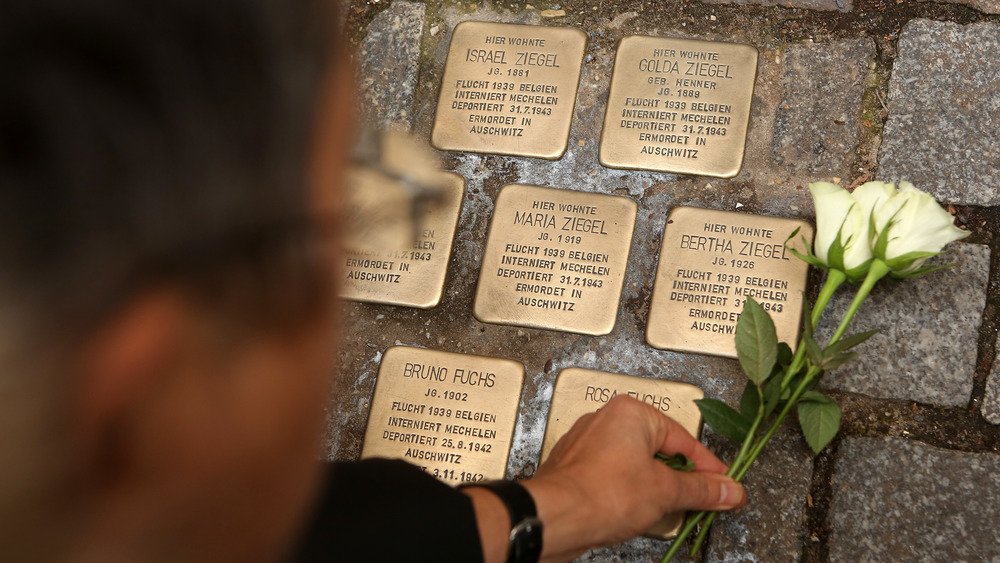The Terrible True Story Of Kristallnacht
Hindsight, it's said, is 20/20, and it's with the benefit of hindsight that people can look back at history to see just where things started to take a serious turn — oftentimes, for the worse.
One of those days where events were set on a road with very few exits was Nov. 9, 1938. That's the night that would come to be known as Kristallnacht, which translates to "Night of Broken Glass." That's also the night, says History, that the world — and particularly, Europe's Jewish population — realized just how serious Adolf Hitler was. It wasn't about rules and restrictions anymore, it was about violence.
Hate and discrimination is certainly nothing new, and when Hitler took power in 1933, he made no secret of his feelings toward German Jews. But when the sun rose on Nov. 10, 1938, the day that dawned was very, very different. Jewish families realized just how much worse it was going to get, and many started making plans to leave the country they called home. Others picked up the pieces of their broken lives, mourned the dead, and tried to prepare for what was to come.
Some things no one can be prepared for, and Kristallnacht was the night that kicked it all off — and legitimized the use of violence against an entire group of people.
Trouble had been brewing for a long time
Adolf Hitler's hatred for the minorities living in Germany was absolutely not a surprise to anyone, and according to The National WWII Museum in New Orleans, he'd made that all quite clear from the beginning of his political career. The Nazi party was built on one major ideal — the Treaty of Versailles had been written to cripple Germany and prevent her from becoming the world leader that she should be, and it was Germany's minorities — particularly those of Jewish faith and those of communist political beliefs — that had allowed her to fall.
Way back in 1922, Hitler gave a speech in Munich and had this to say about the future of Germany — "There are only two possibilities. Either victory of the Aryan, or annihilation of the Aryan and the victory of the Jew."
It doesn't get much more "us versus them" than that, and when Hitler took power, he made it immediately clear that he'd meant what he said. The Jewish Virtual Library says that in the same year he was appointed chancellor, he issued boycotts against Jewish-owned businesses and outlawed the Jewish practice of kosher butchering. Over the next few years, more and more laws were passed — including a 1938 law that made it mandatory for Jews to carry cards identifying them as members of their faith. Then, in 1938, things got officially violent.
The justification for Kristallnacht
According to The Jewish Virtual Library, the events that set Germany on the path to Kristallnacht started not long after the government started requiring all Jewish residents to carry identification cards, with the apprehension of 17,000 Polish Jews. When Poland refused to re-admit their citizens into their country, many were shipped off to so-called "relocation camps."
That included the Grynszpan family. They'd been living in Hanover since 1911, but when German police showed up on their doorstep, they had no choice but to close their store, hand all their worldly possessions over to the German government, and leave, becoming just one family among thousands of people who were loaded onto trains and sent toward the Polish border. The Holocaust Education & Archive Research Team says that when the trains came to the end of the line, they were told to keep walking.
Son Herschel Grynszpan (pictured left) was in Paris when he heard what had happened to his family. On November 7, Grynszpan wrote his parents a goodbye letter, bought a gun, and headed to Paris' German Embassy. There, he shot a low-ranking German official named Ernst vom Rath (right), who died several days later.
Almost immediately, PBS says that Joseph Goebbels — then the propaganda minister — started calling publicly for vengeance. Meanwhile, Grynszpan was shuttled between several Gestapo prisons and was later reported to have died on May 8, 1945.
The specific orders that were given
PBS says that Joseph Goebbels' rhetoric left little room for interpretation. He stirred the public into a frenzy as he preached that German Jews were to blame for the death of a Nazi official, and they needed to be held accountable. Meanwhile, Reinhard Heydrich (pictured center) was drafting a letter.
Heydrich was the head of the Security Service, and according to Britannica, he was also known as "The Hangman." It was Heydrich who wrote and sent new orders to police headquarters across the country in a telegram deemed "SECRET!" (via Facing History and Ourselves) and suggested that law enforcement needed to get ready for "demonstrations throughout the Reich."
The telegram instructed law enforcement to do so by getting in touch with local Nazi leaders for more information about what was going to happen in their district, because "demonstration" was sort of code for "mass violence, murder, destruction, and arrests," which the Nazi party didn't want law enforcement interfering with or breaking up.
Along with instructions to obey local Nazi leaders, police departments were given specific instructions — "Stores and residences of Jews may only be destroyed but not looted," "demonstrations in progress should not be prevented by the police," and "many Jews — particularly affluent Jews — are to be arrested in all districts as can be accommodated in existing detention facilities."
November 9, 1938
Violence broke out on the night of November 9 and carried over into the morning of the November 10. All across Germany — as well as Austria and other areas occupied by the German military — Jewish homes, business, and synagogues were targeted and destroyed by mobs stirred by Goebbels' propaganda... which added that while the Nazi Party wasn't technically organizing protests against the "World Jewry" that had supposedly been behind an assassination conspiracy, they were totally cool with it if people wanted to go ahead and riot to show their allegiance to the party.
And they absolutely did. Led by the Hitler Youth and the SA (storm troopers) — who donned civilian clothing to help promote the idea that this was just the will of the people — the not-so-spontaneous riots destroyed somewhere around 7,500 shops and businesses, burned hundreds of synagogues, and killed an unknown number of people. (The United States Holocaust Memorial Museum says that even though it's widely considered that 91 people lost their lives that night, the death toll might be in the hundreds.)
What happened immediately after the night that would become known as Kristallnacht — a reference to the broken windows of homes, businesses, and places of worship — would make it clear that this wasn't just a one-time thing. Around 30,000 Jewish men were arrested and sent to the concentration camps, which had already been set up to house those who were deemed to be enemies of the state.
The violence was widespread
Kristallnacht wasn't just a few isolated pockets of violence that popped up in a few cities, it was shockingly widespread. From Kiel, Luebeck, and Hamburg in the north to Dusseldorf and Cologne in the west, Munich in the south, and Oppein in the east, vandalism and targeted violence erupted across Germany. The scale was unprecedented, and according to the map of incidents published by the United States Holocaust Memorial Museum, they were only able to label cities that had their synagogues destroyed — there was simply violence in too many towns to show on the map.
There were riots in cities like Vienna, Salzburg, and Graz, and in East Prussia, too, meaning cities hundreds and hundreds of miles apart were all burning on the same night.
According to PBS, the international media reported on the violence — the head of Munich's only Jewish bank had committed suicide alongside his wife, while his business partner was arrested and sent to a concentration camp. Families — and children — were thrown out of their own homes in Nurnberg, and in Vienna, Jews were forced onto trucks and then taken to local synagogues, which they were made to destroy themselves. Crowds forced their way into old-age care facilities, then burned the prayer books they stole.
On November 11, The Cleveland Press reported, "But Jews, desperate, with no place to go and with no hope of help from abroad, feared that the climax was yet to come..."
The Jewish community was blamed for Kristallnacht
In the days following Kristallnacht, the Jewish community not only had to deal with the devastating consequences of widespread rioting and the arrest of thousands, but they were also officially blamed for it.
Immediately afterwards, the United States Holocaust Memorial Museum says that the government not only declared the Jewish community at fault but confiscated all the insurance payments that they were eligible for receiving after the vandalism of their homes and businesses. On November 12, the Reichsgesetzblatt (Reich Law Gazette) published this — "The antagonistic stance of the Jewry toward the German people and Reich, which does not shrink even from cowardly acts of murder, requires us to stage decisive defense and require hard reparations."
In other words? The community was then fined one billion Reichsmark. Accounting for inflation and exchange rate, that's the equivalent of $7.4 billion in the United States in 2019. The Judisches Museum Berlin says they wasted no time in starting to collect, either. The 84-year-old widow Helene Gumpert got her first bill on Dec. 13, 1938. Her first payment, it said, was due on the 15th, and there were three more additional payments due after that.
Margot Friedlander: when the synagogues burned
She was Margot Bendheim when Adolf Hitler came to power, and she was 17 years old when Kristallnacht changed Germany forever.
After spending 64 years in New York, NPR reported that she — now Margot Friedlander — had decided to return to Germany. Her citizenship was restored, she moved to Berlin, and she made it clear that she had a purpose. "As a survivor, I feel that I do something for the people who cannot speak for themselves anymore."
Her family — mother, father, and brother — all died during the war, and she recalled that it was Kristallnacht that made them realize how bad things were going to get. She remembered, "I did not hear fire engines and we understood then that they didn't come because they wanted the synagogues to burn. We never thought that Germans would stand by, and not do something about it."
With that realization came another — that it was time to leave Germany. They had waited too long to try to emigrate, though, and according to the Berlin Spectator, she went into hiding while her family was sent to Auschwitz. She was eventually sent to the concentration camp/ghetto of Theresienstadt but survived the war and left for the U.S. in 1946. Even upon her return to Germany, the scars remain. "I don't want them to tell me, 'We did not know.' Because this is something that I will not accept. Everybody knew something."
Miriam Ron: it was such a nice neighborhood
Miriam Ron shared her memories of growing up in Leipzig, Germany, with Yad Vashem, and she recalled her earliest memories of her home. "We were on very good terms with our non-Jewish neighbors. ... We lived on Beethoven Street, which was a nice neighborhood."
That started to come to an end one day in 1935. Ron says she and her father were summoned to the window by people outside, and what they saw was terrifying — a parade of people, chanting, "When the blood of Jews will be on our knives, we will be happy."
Ron's father — a former World War I refugee — knew what it was like and moved in an attempt to keep his family safe. It didn't work, and just ten days before Kristallnacht, they narrowly avoided being sent to Poland.
On the morning of November 10, a friend knocked on their door and warned them that there were people coming from them. They ran through the streets as mayhem descended around them, and when they finally found a taxi that would accept a Jewish fare, he took them to the Polish consulate — where they had garbage dumped on them between the taxi and the safety of Polish soil. When they returned to their home that night, they found everything had been destroyed. Still, they stayed, until Ron's piano teacher got a package in the mail — postage due. It was her husband's ashes.
Ruth Winkelmann: "We'll try to live through it."
Ruth Winkelmann was a 10-year-old living in Berlin in November of 1938, and when she talked to the BBC about her memories of Kristallnacht, she said one of the most vivid was of her father, hugging her and her sister, and telling them, "This is the beginning of a very difficult time, and we'll try to live through it."
He did not. Hermann Jacks was sent to Auschwitz in 1943, and among her most treasured possessions are the postcards he sent her before he died there in January of 1944.
She remembered going to school on the morning of the November 10, past broken windows and past a Jewish man being beaten by storm troopers. It was only when they got there that they heard what had been happening, and even then, storm troopers moved through. They fled through a network of stairways and attics until they could get home, only to find something even more frightening than the men in the streets — parents who were scared.
She and her mother survived the war, but her younger sister died as they hid in a neighbor's shed to avoid detection. She said, "In retrospect, I became a grown-up on that day. The pogrom night took away my childhood." Today, her school and her synagogue are rebuilt, and she says, "When I stand here and look up at the clouds, I think that my father is watching over me, and it's a good feeling."
What, exactly, is a pogrom?
Kristallnacht is often described as a "pogrom," and it's worth looking at exactly what that means — because there's a shocking number of times they've happened.
According to the United States Holocaust Memorial Museum, the word is actually Russian. It means, "to demolish violently," and that's a pretty apt description of nights like that of Nov. 9, 1938.
Historically speaking, pogroms have usually targeted Jewish populations, but that hasn't always been the case. Other areas divided by religious strife have seen their share of these violent riots, too. The Irish Times described the Catholic vs. Protestant destruction and killings that swept through Belfast between 1920 and 1922 as pogroms.
The term has been around for a long time, too. It was first used to describe riots fueled by anti-Jewish sentiment way back in 1821, and by the time of Kristallnacht, tens of thousands had been killed in these anti-Jewish riots. They continued throughout the war and destroyed entire communities... and they continued after the war, too. Kielce, Poland, had its own pogrom in 1946, when 42 people were killed amid the violence that broke out after circulation of unfounded rumors of ritual sacrifice.
The world watched as Germany set itself on fire
Headlines were filled with news of what had happened in Germany, and the nations of the world responded... then pretty much just went about their business.
According to History, all the major media outlets published detailed descriptions of what had happened to Germany's Jewish community on the Night of Broken Glass. They also called on world leaders to do something. As the Hartford Courant put it, "Not to express themselves would be a denial of their deepest instincts as civilized human beings."
But at the same time, some — like the New York Daily News and the popular radio broadcaster and Catholic priest Father Charles Coughlin — went the route of blaming the Jewish community for what they had suffered, making for something of a muddied reaction.
It took U.S. President Franklin Delano Roosevelt four days to take any action, and when he did, it was simply to pull the U.S. ambassador out of Germany. Other nations had similar responses, and Facing History and Ourselves says that both Britain and France acknowledged that it had happened... and then "expressed 'deep and widespread sympathy,'" while not extending aid or loosening immigration laws for those looking to flee.
Germany's stance in the 21st century
Fast forward to the 21st century, and Germany has taken responsibility for the atrocities committed in the not-too-distant past.
In 2020, Chancellor Angela Merkel added a statement to the nation's "Let there be Light" event, in which institutions around the country were lit in remembrance of Kristallnacht. She said (via DW), "We remember the disgrace of November 9, 1938, the pogroms against Jewish fellow citizens throughout the country, the people driven to their deaths, the burning synagogues, the destroyed stores. We commemorate the victims of the crime committed by Germany against humanity, the Shoah, in shame."
Scattered around Germany are the Stolperstein, or "stumbling stones." They're small brass plaques — about the size of cobblestones — placed across the country in locations where individuals persecuted by the Nazis once lived (via NPR). They're engraved with names, dates of their deportations, and sometimes, of their deaths. And while some German citizens take the time to polish and care for those little brass plaques, that doesn't mean it's over.
In 2016, The Independent reported that the anniversary of Kristallnacht brought vandalism and smashed windows to Jewish businesses in Philadelphia, and in 2019, The Jerusalem Post reported that there had been instances of vandalism across Europe in a series of incidents — from Germany to Denmark to England — reminiscent of that terrible night so many decades ago.
